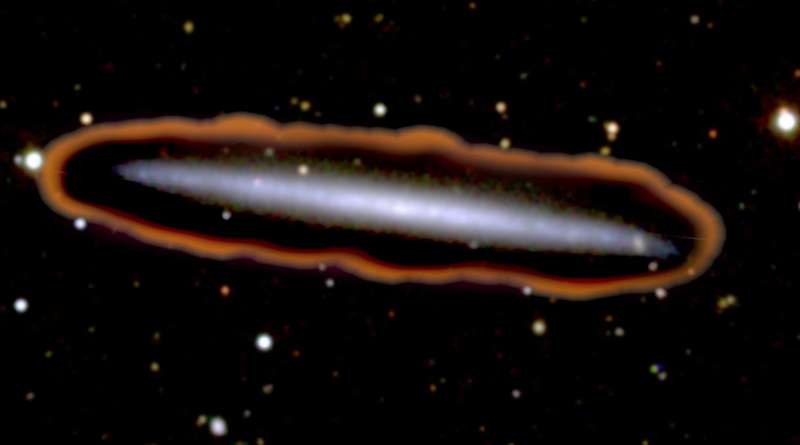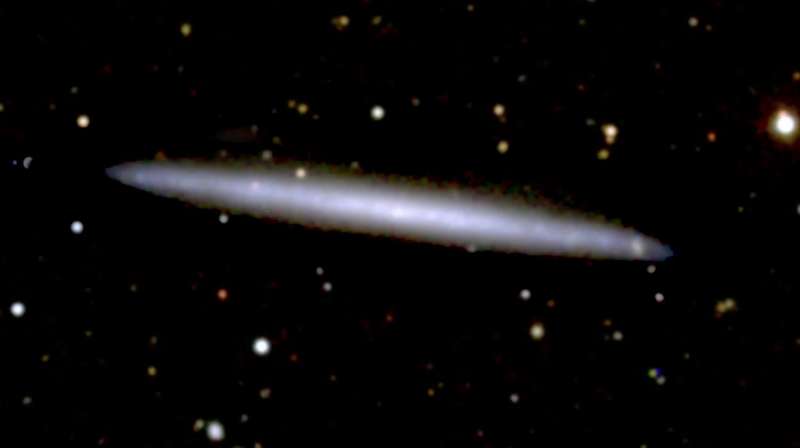Universe's ultraviolet background could provide clues about missing galaxies

Astronomers have developed a way to detect the ultraviolet (UV) background of the Universe, which could help explain why there are so few small galaxies in the cosmos.
UV radiation is invisible but shows up as visible red light when it interacts with gas.
An international team of researchers led by Durham University, UK, has now found a way to measure it using instruments on Earth.
The researchers said their method can be used to measure the evolution of the UV background through cosmic time, mapping how and when it suppresses the formation of small galaxies.
The study could also help produce more accurate computer simulations of the evolution of the Universe.
The findings are published today in the journal Monthly Notices of the Royal Astronomical Society.
UV radiation - a type of radiation also given out by our Sun - is found throughout the Universe and strips smaller galaxies of the gas that forms stars, effectively stunting their growth.
It is believed to be the reason why some larger galaxies like our Milky Way don't have many smaller companion galaxies.
Simulations show that there should be more small galaxies in the Universe, but UV radiation essentially stopped them from developing by depriving them of the gas they need to form stars.
Larger galaxies like the Milky Way were able to withstand this cosmic blast because of the thick gas clouds surrounding them.
Lead author Dr Michele Fumagalli, in the Institute for Computational Cosmology and Centre for Extragalactic Astronomy, at Durham University, said: "Massive stars and supermassive black holes produce huge amounts of ultraviolet radiation, and their combined radiation builds-up this ultraviolet background.
"This UV radiation excites the gas in the Universe, causing it to emit red light in a similar way that the gas inside a fluorescent bulb is excited to produce visible light.
"Our research means we now have the ability to measure and map this UV radiation which will help us to further refine models of galaxy formation."
Co-author Professor Simon Morris, in the Centre for Extragalactic Astronomy, Durham University, added: "Ultimately this could help us learn more about the evolution of the Universe and why there are so few small galaxies."
Researchers pointed the Multi Unit Spectroscopic Explorer (MUSE), an instrument of the European Southern Observatory's Very-Large Telescope, in Chile, at the galaxy UGC 7321, which lies at a distance of 30 million light years from Earth.

MUSE provides a spectrum, or band of colours, for each pixel in the image allowing the researchers to map the red light produced by the UV radiation illuminating the gas in that galaxy.
The research, funded in the UK by the Science and Technology Facilities Council, could also help scientists predict the temperature of the cosmic gas with more accuracy.
Co-author Professor Tom Theuns, in Durham University's Institute for Computational Cosmology, said: "Ultraviolet radiation heats the cosmic gas to temperatures higher than that of the surface of the Sun.
"Such hot gas will not cool to make stars in small galaxies. This explains why there are so few small galaxies in the Universe, and also why our Milky Way has so few small satellite galaxies."
More information: Michele Fumagalli et al, A measurement of the z = 0 UV background from Hα fluorescence., Monthly Notices of the Royal Astronomical Society (2017). DOI: 10.1093/mnras/stx398
Journal information: Monthly Notices of the Royal Astronomical Society
Provided by Durham University




















